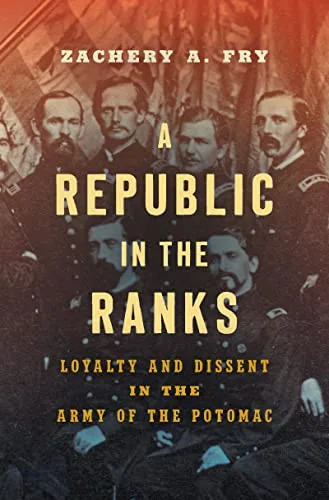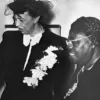Suddenly thrust into the role of national protectors, Civil War soldiers became intimately entwined with the fate of the Union. Histories of the front lines often detail their encounters with the brutality of the battlefield, miserable conditions, and the cruelty of slavery. A Republic in the Ranks provides a new perspective on this military history by examining the internal political divisions among enlisted men. Zachery A. Fry reimagines the camps and battlegrounds of the Army of the Potomac as focal points of ideological debate. Enlisted men not only reflected partisan divides of the broader Northern public but directly engaged in the political process through correspondence, voting, and political resolutions. This book sheds light upon mobilization within the ranks to reframe notions of political space and activity during the Civil War.
Part of the University of North Carolina Press’ Civil War America “Landmark Series,” edited by Peter S. Carmichael, Caroline E. Janney, and Aaron Sheehan-Dean, the book contributes to broader scholarship examining how the Civil War transformed the national government and its relationship with the American people. Divided into two sections, A Republic in the Ranks explores how enlisted men debated the meaning of partisan loyalty in the early stages of the war and understood the significance of their political voice and how junior officers in particular directed the political engagement of the ranks. In addition to enlistment and voting records, Fry sifted through mid-to-late war newspaper accounts to reveal soldiers’ participation in both local and national politics. His reliance on a wide range of sources allows this book to trace the evolution of the army’s collective political consciousness throughout the war.
Soldiers simultaneously embraced the independence of military manhood and sought to replicate the comforts of home. Charged with electing their own junior officers, volunteer companies immediately engaged in partisan political processes. A Republic in the Ranks frames the relationship between junior officers and enlisted men as both fraternal and patriarchal. The organization of Union troops contributed to the emerging Republican consensus. Elected officers both directed the military service of their regiment and modeled moral virtue and professionalism for inexperienced soldiers. Loyalty to the Union flag and popular military figures like General McClellan initially fostered unity among men who were otherwise divided by education, ethnicity, and class. As confidence in Union leadership waned, regiments relied upon internal leadership to give voice to mutual complaints. Fry highlights the political awareness of enlisted men who filtered their war-time experiences and trauma through partisan perspectives.
The year 1863 served as a critical military turning point during the Civil War, and political engagement increased leading up to the 1864 presidential election. After months of exhausting service, soldiers not only confronted the terror of the battlefield and the reality of slavery in the South, but forged deep bonds within individual regiments. Concern about peace-at-any-price measures, pro-Confederate secret societies, and disloyalty in the ranks prompted sixty-one regiments to issue political manifestos in support of the Lincoln administration and Republican policies in 1863. Fry demonstrates the power and impact of these political resolutions, consciously crafted to demonstrate the collective voice of the armed forces. Significantly, nine resolutions with broad regional representation explicitly addressed slavery. Sentiments included endorsements of the Emancipation Proclamation, support for the enlistment of Black soldiers, and declarations that situated the abolition of slavery at the center of the war effort. These political manifestos reflected the ideological unification of enlisted men, and the emergence of the Army of the Potomac as a social and political institution neatly aligned with Republican initiatives.
Fry’s A Republic in the Ranks also explores political campaigning within the Union Army, first through surrogate ballots and later through active engagement in public discourse. Lengthy furloughs allowed soldiers to speak in public meetings, take part in local elections, and encourage support of absentee voting among the armed forces. Debates over whether enlisted men should or could cast ballots in the 1864 presidential election led to sophisticated political campaigning among soldiers and veterans. Fry identifies the formation of veteran’s clubs as an extension of the army apparatus. Pressure from these organizations and enlisted men themselves led to Edwin M. Stanton’s General Order No. 265, which outlined procedures for wartime absentee voting. Through highlighting this process, the book situates the transformation from civilian to soldier at the heart of the political transformations of the Civil War era.

Portrait of Edwin Stanton (Library of Congress/Wikimedia)
Additionally, Fry provides six detailed appendices that both demonstrate the archival foundation of this book and direct historians to examine underutilized army records. In addition to a methodological essay, these include a bibliography of the 1863 political resolutions, regimental participation in the Philadelphia Free Military School, and voting returns for the 1863 and 1864 elections. The titles of these political resolutions, mostly published in local newspapers, are eye-catching. Reflecting Fry’s assertion of an emerging institutional identity for the Army of the Potomac, they claim to represent “The Loyal Voice,” “Noble Sentiments,” and “The Patriotism of the Soldiers.”[1] Voting returns from the 1864 election also offer a glimpse into partisan loyalty among enlisted men. Even though thousands of ballots from New York, Connecticut, and Minnesota were never counted, these returns, sometimes published in local papers, represent the public political identities of enlisted men.
Fry addresses the revolutionary enlistment of nearly two hundred thousand men of color into the Union army, particularly the establishment of “candidate schools” to train white commanding officers. However, he leaves space for examining the impact of Black enlistment on the developing political identity of the Union army. Nine of sixty-three resolutions made by white soldiers offered an explicit endorsement of emancipation, but Fry’s analysis does not examine how white enlisted men interacted with enlisted men of color beyond their role as commanding officers. It is not clear to what extent their campaigning reflected burgeoning claims for the expansion of political rights in the post war period. Furthermore, Fry does not consider the unique brand of political consciousness developed within Black regiments themselves. The segregation of the armed forces and the decision to appoint white officers to Black regiments precluded the opportunity for African American soldiers to elect junior officers and enact the political process within their ranks. The decision to enlist alone was an overtly political act, imbued with claims for full citizenship and the extension of political rights. Enlisted men of color participated in the political process and campaigned through actions, if not words, for the right to vote. Reframing African American soldiers’ military participation through Fry’s political lens might open a new avenue of exploration.
Kathryn Angelica is a PhD Candidate at the University of Connecticut. Her dissertation explores Black and white women’s activism in the Civil War era.
The Strategy Bridge is read, respected, and referenced across the worldwide national security community—in conversation, education, and professional and academic discourse.
Thank you for being a part of the The Strategy Bridge community. Together, we can #BuildTheBridge.
Header Image: Union soldiers pose during the Siege of Petersburg in Virginia in 1864. (Library of Congress)
Notes:
[1] Zachery A. Fry, A Republic in the Ranks: Loyalty and Dissent in the Army of the Potomac (Chapel Hill, NC: University of North Carolina Press, 2020), 193.





